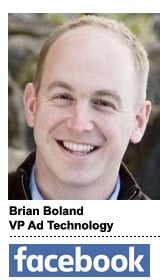The word is often bandied about to describe Facebook’s ad tech business. It has become a rallying cry for smaller competitors as well as independent observers concerned about what they see as a return to AOL-style walled gardens.
It would seem the naysayers have struck a nerve. Brian Boland, Facebook’s VP of advertising technology, tells AdExchanger that he has fielded questions from partners and customers on the open/closed meme. And he’s annoyed by them.
“Every time there’s an acquisition or a thing we launch, there tends to be a lot of discussion around open vs. closed,” Boland said during a recent interview at Facebook’s Menlo Park offices. “It makes for great rhetoric, but it misses the point.”
So what’s the point? “The point is around business outcomes. We are focused on driving business outcomes for advertisers.”
Boland outlines four focus areas under this headline: unity, quality, ease of use and scale.
“Unity” is a bid to collapse the ad tech supply chain by consolidating planning, delivery and measurement into a single toolkit. Dozens of companies, ranging from AOL/Verizon to Adobe, are chasing a similar opportunity – an opportunity in which the LUMAscape figures centrally as the eternal bogeyman. But industry watchers consider Facebook the only company that can challenge Google’s ad tech dominance.
“Quality” is a push for improved ad relevance and user experience. ‘Nuff said.
“Ease of use” is about making the tools more accessible from an integration and workflow standpoint.
And “scale” is about extending the reach and frequency of Facebook’s media offering to outside publishers, especially app developers.
“It’s more about integration than it is about ‘open vs. closed,’ whatever those words mean,” Boland continued. “They’re wonderful to apply against pretty much any argument you want to make. You can call anything ‘open,’ or you can call anything ‘closed.'”
But Facebook’s “closed” critics have a point. They’re wary because Facebook does not report user-level data about ad exposures in a way that marketers can use for attribution and optimization outside the Facebook platform. Attribution down to the individual customer level is possible, but only for media trafficked through Facebook. The company’s powerful people-based marketing approach is of limited value to a marketer using a third-party DMP to analyze and target customers across media suppliers.
“Knowing in aggregate just isn’t good enough,” LiveIntent CEO Matt Keiser wrote in a May column for AdExchanger.
Boland is aware of these concerns, but says those narrowly focused on “open vs. closed” are missing a larger shift that’s underway in how data is managed and used, both by individuals and by businesses. Companies like Facebook and Google, which use billions of direct consumer cross-device relationships to power their scaled ad tech platform businesses, face a higher bar in protecting those users’ identities.
“We’re in a transition,” Boland said. “The industry on desktop evolved with complete fluidity of data and little to no user protections. We are a principled company. As we have evolved, we have wanted to move to a better path. I don’t believe people’s data should be flowing across the ecosystem. It’s not transparent to people, and it’s not controlled.”
If being principled means standing in the way of a holy grail or two – holistic attribution? customer life cycle analysis? – so be it.
“Data is critically important [to marketers], and the future of marketing is very data-driven,” Boland continued. “But people have rights to their data and should be able to control that data.”
Businesses have data rights too, he said.
“We’ve built out a future-thinking approach to data,” he said. “There are rights on Atlas, where a business user does not contribute their data to other advertisers.”















